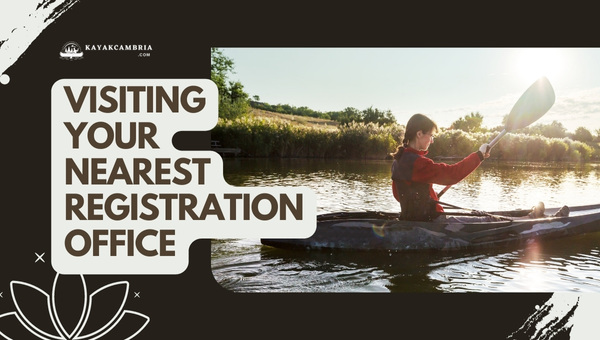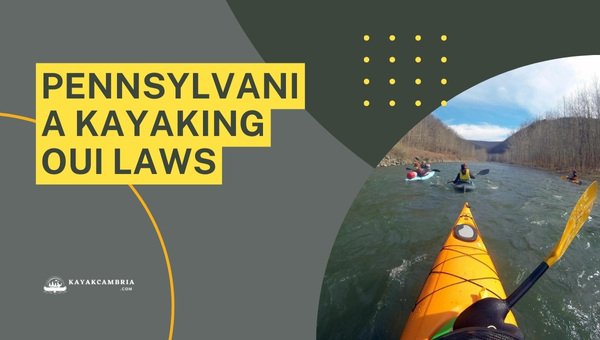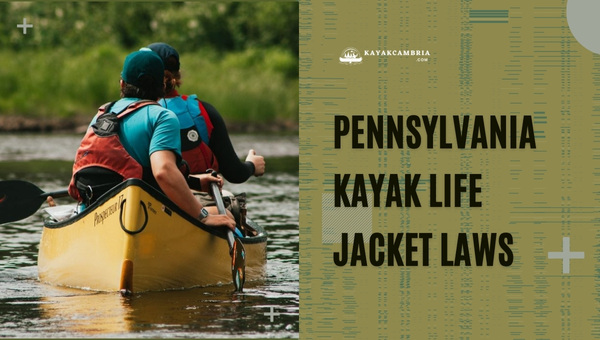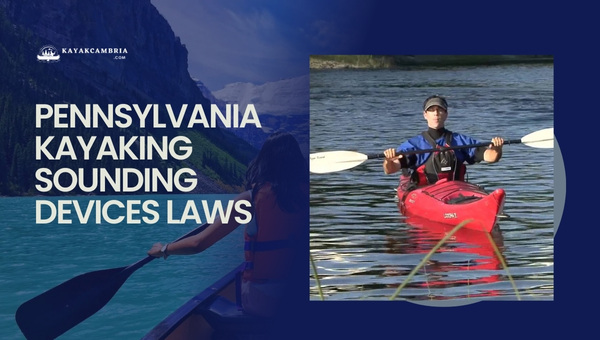If you’re a kayak enthusiast like me and you live in Pennsylvania, you might be wondering how to register a kayak in PA. Don’t worry, I’ve got you covered! In Pennsylvania, registering your kayak is not only a legal requirement but also helps to ensure the safety and enjoyment of this popular recreational activity.
Before diving into the registration process, it’s essential to understand when you need to register your kayak. In Pennsylvania, kayaks, canoes, or paddleboards that are powered by a motor or used for fishing in PA state park waters or on the Delaware River Estuary require registration. If your kayak doesn’t fall into these categories, you’re good to go without registering.
Now that we know if registration is necessary, let’s talk about how to register a kayak in Pennsylvania. You’ll need to complete a registration application form, provide proof of ownership, and pay the applicable registration fees. Once all the requirements are met, you’ll receive a registration card, validation decals, and a registration number assigned to your kayak. Display these decals and numbers correctly on your kayak and you’re ready to hit the water, worry-free!
Contents
Contents
Understanding Kayak Registration in PA

Registering a kayak in Pennsylvania is important for maintaining the legality of your watercraft use in the state. There are specific steps and requirements to be followed for successful registration.
First, it’s crucial to understand that not all types of watercraft require registration. In Pennsylvania, you’re only required to register your kayak if it will be used with a motor, whether electric or gas. Non-powered kayaks, canoes, and paddleboards don’t require registration.
To start the registration process, you’ll need to gather the following documents:
- Proof of Ownership: This can be a bill of sale, manufacturer’s statement of origin (MSO), or a properly assigned title.
- Completed Application for PA Boat Registration and/or Title (Form REV-336). This form can be downloaded from the PA Fish and Boat Commission website.
- Appropriate registration and titling fees.
To help you understand the fees associated with registration, here’s a table outlining the costs:
| Registration Type | Fee |
| Unpowered Kayak (2 years) | $22 |
| Motorized Kayak (2 years) | $32 |
On top of these registration fees, you might need to pay:
- Sales tax on the purchase price of the kayak.
- A titling fee of $15, if applicable.
Once you’ve gathered all the necessary documents and payment, submit your application in one of the following ways:
- Online: Visit the PA Fish and Boat Commission’s online portal and follow the instructions provided.
- In-Person: Visit a PA Fish and Boat Commission office or an authorized agent.
- By Mail: Send the completed application, proof of ownership, and payment to the PA Fish and Boat Commission.
After you’ve completed the registration process, you’ll receive an official Certificate of Registration, decals with registration numbers, and, if applicable, a title. Make sure to:
- Display the registration numbers and decals on your kayak, following the specified format provided by the PA Fish and Boat Commission.
- Keep your Certificate of Registration on board when using your kayak.
Finding the Right Forms and Materials

When I set out to learn how to register a kayak in Pennsylvania, I quickly discovered the importance of finding and completing the necessary forms and materials. Let me share with you a step-by-step process to guide you through the registration process. By following these instructions, you’ll be able to legally use your kayak in PA without encountering any issues.
Before we dive into the details, it’s essential to understand that unpowered boats like kayaks are required to be registered if they’re used in Pennsylvania waters. Now, let’s take a look at how to register a kayak in PA.
First things first, you’ll need to navigate to the Pennsylvania Fish & Boat Commission’s website to access the Application for PA Boat Registration and/or Boat Title (REV-336) form, which you can find here. This PDF document provides step-by-step instructions and serves as the main boat registration form.
Here are some pointers for filling out the form:
- Your kayak will likely be classified as an unpowered boat.
- Have handy your kayak’s manufacturer, model, and hull identification number (HIN).
- If your kayak is new or previously registered in another state, you’ll need to provide proof of ownership in the form of a sales receipt, certificate of origin, or title.
With your application form completed and ready to go, you’ll also need to determine your registration fee. The fee for unpowered boats in PA is listed at \$18 for a two-year registration, which also includes a $2 processing fee. Check this link for information on other fees abstract.
Don’t forget that renewing your registration every two years is crucial to staying legal on PA waters.
Finally, you’ll need to submit your application, proof of ownership (if applicable), and payment to one of the following locations:
- A Pennsylvania Fish and Boat Commission Regional Office
- The PFBC Headquarters in Harrisburg
- An Approved Boat Registration Agent near you
By following these guidelines, you’ll have all the right forms and materials necessary to register your kayak in Pennsylvania, ensuring a hassle-free and enjoyable kayaking experience in PA waters.
Preparing Your Kayak for Registration

So, you’ve decided to register your kayak in Pennsylvania. It’s an important step to ensure compliance with state laws and enjoy hassle-free kayaking adventures. Before diving into the process, let’s look at what you’ll need to prepare your kayak for registration and make the process as smooth as possible.
First and foremost, make sure your kayak is in good working condition. If you’ve recently acquired your kayak or it’s been sitting idle for a while, you might want to give it a thorough inspection. Check for any damage, such as cracks or leaks, that might need repair. Ensure that all equipment, like paddles and life vests, are in suitable shape for use.
Next, gather the necessary documents for registration. In Pennsylvania, you’re required to provide proof of ownership for your kayak. This can be in the form of a bill of sale, a manufacturer’s certificate of origin (MCO), or a title. If you purchased the kayak from a private seller, it’s crucial to obtain a signed, dated, and notarized bill of sale. The document should include the following information:
- Seller and buyer’s full names and addresses
- Description of the kayak (make, model, year, and hull identification number)
- Purchase price and date
- Signatures of both the seller and buyer
You should also locate the Hull Identification Number (HIN) on your kayak. The HIN is a 12-digit serial number assigned by the manufacturer or, in the case of home-built kayaks, by the owner. It’s usually found on the right side of the kayak’s stern. During the registration process, you’ll be asked to provide this number along with other pertinent details about your vessel.
In addition to the required documents, you’ll need to pay registration fees. Pennsylvania has a tiered fee system based on the length of your kayak. Keep in mind that unpowered kayaks, such as those propelled by paddles, are subject to different registration fees than powered ones. The table below outlines the fees for unpowered kayaks in Pennsylvania:
| Kayak Length | Registration Fee |
| Up to 4ft | $18 |
| 4ft to 16ft | $22 |
| Over 16ft | $26 |
With all these factors in place, you’re ready to register your kayak in PA. Once you’ve submitted your application and fees to the Pennsylvania Fish and Boat Commission (PFBC), you’ll receive your registration decals and documentation. Now you’re all set to enjoy Pennsylvania’s beautiful waterways while knowing you’re in compliance with state regulations.
Visiting Your Nearest Registration Office

It’s essential to gather the necessary documents beforehand so you can ensure a smooth registration process. Let’s talk about the steps you’ll need to take before heading to the registration office, as well as the importance of obtaining the proper registration for your kayak in PA.
First things first, you’ll need to gather some key documents to bring along to the registration office. These typically include:
- Proof of ownership or a notarized bill of sale
- A completed application form, which can be found on the PA Fish and Boat Commission’s website
- An acceptable form of payment, such as a credit or debit card, cash, check, or money order
Double-check with your local registration office if there are any additional documents required.
Here are a few important reminders about how to register a kayak in PA:
- Kayaks shorter than 14 feet may not require registration if used exclusively for non-commercial purposes.
- Registering your kayak is vital for access to public launching sites or lakes throughout Pennsylvania.
- Ensure you’re familiar with PA paddling laws and regulations to avoid any fines or penalties.
You don’t need a calendar! Kayak registrations are valid for two years from the date of issuance. Once you have all the necessary documents, you can proceed to locate your nearest registration office. The Pennsylvania Fish and Boat Commission’s website provides an interactive Agent Locator tool which makes it easy to find an office close to you.
Additionally, it’s worth noting that you can also register your kayak through the mail. To do this, download and print the application form from the PA Fish and Boat Commission’s website, and send the completed form along with the required documents and payment to the address provided on the form. While this option might take a bit longer, it’s a convenient choice if you’re unable to visit an office in person.
When preparing to register your kayak in Pennsylvania, be sure to gather all necessary documents, familiarize yourself with the PA paddling laws, and pay a visit to your nearest registration office. By following these steps, you’ll be on your way to enjoying the many wonderful waters throughout the state!
Submitting an Application through Mail

When it comes to knowing how to register a kayak in Pennsylvania (PA), one option is submitting an application through mail. By following these steps, you’ll be able to successfully register your kayak and enjoy PA’s gorgeous waterways.
The first step in the process is to gather all necessary documentation. Before mailing your application, double-check that you have the following items:
- Completed Pennsylvania Fish and Boat Commission (PFBC) boat registration application
- Proof of ownership, such as a bill of sale or manufacturer’s statement of origin
- Payment for the registration fee, which varies depending on the length of your kayak and your choice of a 1 or 2-year registration
Once you’ve gathered everything, it’s time to fill out the PFBC boat registration application. Be sure to provide accurate information and complete all sections. It’s essential to be thorough, as missing or incorrect details may delay your application.
With the application completed, move on to making a copy of your proof of ownership, which is required for the PFBC’s records. It’s a good idea to retain the original documents for your own records.
Next, you need to calculate the appropriate registration fee for your kayak. The fees related to kayak registration in PA are as follows:
| Kayak Length | 1-Year Registration | 2-Year Registration |
| Up to 16 ft | $18 | $34 |
| Over 16 ft | $22 | $43 |
Lastly, prepare your payment for the registration fee. Checks or money orders should be made payable to “PFBC.” Do not send cash through the mail.
Now that you’ve got everything ready, package all your documents, including the completed application, proof of ownership, and payment, into an envelope. Mail it to the following address:
Pennsylvania Fish and Boat Commission P.O. Box 67000 Harrisburg, PA 17106-7000
You can expect your registration to be completed within four to six weeks once your application is received. Successfully navigating the mail-in application process for registering a kayak in PA takes some attention to detail, but with this guide, you’ll be out and enjoying the beautiful state waters in no time.
Pursuing Online Registration

Another option available for Pennsylvanian kayak owners is online registration. This method helps avoid long waiting times and streamlines the registration process. In this section, we’ll discuss how to register a kayak in Pennsylvania through the online procedure.
First, you’ll want to visit the Pennsylvania Fish and Boat Commission’s (PFBC) website. Here, you’ll find an online registration portal specifically designed for boat and kayak registration. To commence the process, you need to have an account on their website. If you don’t have an account yet, it’s easy to create one. Once you’re logged in, you’ll find the following steps to register your kayak:
- Locate the “Register/Renew a Boat” option within your account dashboard.
- Enter the required information about your kayak, which includes:
- Make and model
- Length
- Year of manufacture
- Hull material
- Hull identification number (HIN)
- Type of propulsion (paddle or motor)
- Next, you’ll need to provide your personal information, such as:
- Name
- Address
- Phone number
- Email address
- Review and confirm your kayak and personal information prior to submission.
- Make your payment for the registration fee through the online payment system. Pennsylvania offers two registration options: a one-year registration or a two-year registration.
- One-year registration: $18
- Two-year registration: $36
Please note: The registration fees mentioned above are subject to change. To stay up-to-date with the latest fees, visit the PFBC website.
Once you’ve completed the online registration process, you’ll receive a confirmation email and a temporary registration card. The PFBC will also mail your official registration card, decals, and registration number to the address provided during registration. Remember, it’s essential to place the registration number and decals on your kayak correctly.
Keeping Your Registration Up to Date

When it comes to enjoying Pennsylvania’s beautiful waterways in your kayak, it’s crucial to keep your registration up to date. I’ve compiled a few key points and resources to help you do just that.
In Pennsylvania, a kayak registration is valid for two years from the date of issuance. If you’re wondering how to register a kayak in Pennsylvania or when it’s time to renew your registration, this guide will help you stay current.
To stay ahead, mark your calendar for 60 days before the expiration date so you have plenty of time to ensure your registration is renewed. Here’s a quick rundown of what you need to do to keep your kayak registration up to date:
- Verify your boat information: Make sure you have your boat’s make, model, and hull identification number (HIN) accessible. This information is essential when renewing your registration.
- Keep track of registration numbers: Always store your registration number in a safe place. This number will be required for most renewal processes.
- If necessary, update your address: If you’ve moved since you initially registered your kayak, be sure to update your address with the Pennsylvania Fish and Boat Commission.
- Keep your proof of registration: After completing the renewal process, print or save a digital copy of your registration. Keep it in a secure and easily accessible location.
Pennsylvania has set up two main methods to ensure an easy and convenient renewal process for kayak registrations:
- Online renewal: The fastest and most straightforward method for renewing your kayak registration in Pennsylvania is through the PA Fish and Boat Commission’s “The Outdoor Shop” website. Visit the website and follow the instructions for boat registration renewal.
- Mail-in renewal: If you prefer to renew your registration via mail, you can download and print the “Application for Pennsylvania Boat Registration Renewal” (REV-336) from the PA Fish and Boat Commission’s website. Fill out the form and mail it, along with the appropriate fees, to the specified address on the form.
Pennsylvania Kayaking OUI Laws (2025)

If you’re like me, you probably love kayaking and the peaceful serenity it brings while exploring the beautiful waterways in Pennsylvania. In this section, I’ll discuss Pennsylvania’s kayaking OUI laws for both motorized and non-motorized kayaks.
It’s important to note that the State of Pennsylvania has specific laws and regulations regarding Operating Under the Influence (OUI) that apply to motorized and non-motorized kayaks.
1. Motorized Kayaks
If you’ve installed a motor on your kayak or plan on using a motorized kayak in PA, be aware that operating under the influence of alcohol or controlled substances is illegal. The blood alcohol content (BAC) limit for boating OUI in Pennsylvania is 0.08% or higher, just like driving a car. Boat operators, including those navigating motorized kayaks, can face severe penalties if charged with an OUI, such as fines, license suspension, and even jail time.
3. Non-Motorized Kayaks
Good news for non-motorized kayaking enthusiasts! In Pennsylvania, non-motorized kayaks, canoes, and paddleboards are exempt from registration. However, that does not mean you can operate these vessels under the influence. While the OUI laws are less stringent for non-motorized boats, paddlers with a BAC of 0.08% or higher can still face significant fines and penalties. It’s always a good idea to prioritize safety and avoid using alcohol or controlled substances during a paddling trip.
Pennsylvania Kayak Life Jacket Laws (2025)

Safety is paramount while enjoying kayaking adventures, and this includes abiding by the life jacket laws in the State of Pennsylvania.
1. Personal Flotation Devices (PFDs) Requirement
Pennsylvania law requires that each boat or kayak be equipped with a wearable United States Coast Guard-approved Personal Flotation Device (PFD) for each person on board. This means that if you own a kayak and plan on using it in Pennsylvania waters, you must have a life jacket for yourself as well as any other passengers.
2. Children’s PFD Requirements
Children under the age of 12 must wear a United States Coast Guard-approved PFD at all times while on the water in any boat that is 20 feet or smaller. This law applies to kayaks as well, regardless of whether they are motorized or non-motorized.
3. Proper Fit and Readily Accessible
PFDs must be appropriate for the wearer’s size and weight, and they must be in good condition. If a PFD shows signs of wear or damage, it should be replaced immediately. Additionally, life jackets must be easily accessible in case of an emergency. For example, storing the PFD under a seat or in a tightly packed storage compartment doesn’t meet the guideline for easy accessibility.
4. Type III PFDs
The most common life jacket for kayaking or canoeing is a Type III PFD. These life jackets are designed specifically for paddling and allow for freedom of movement and comfort while still providing the necessary flotation in the event of an emergency.
By abiding by Pennsylvania’s kayak life jacket laws, you’ll not only ensure your safety and the safety of those around you but will also avoid receiving any fines or penalties for non-compliance. Remember, safety should be a priority, and wearing a life jacket while kayaking can ultimately save your life!
Pennsylvania Kayaking Lights Laws (2025)

When it comes to paddling in low light or nighttime conditions, it’s crucial to be aware of Pennsylvania’s kayaking lights laws, which ensure the safety of everyone on the water. Here’s a quick rundown of the laws you should keep in mind to ensure a safe and enjoyable paddling experience.
1. Between Sunset and Sunrise
If you plan on paddling your kayak between sunset and sunrise or during periods of restricted visibility, Pennsylvania law requires you to equip your kayak with proper lighting. Kayaks, like all other watercraft, must display navigation lights to signal their presence to other boats.
2. Displaying Lights
For kayaks, a simple yet effective setup is to display a white light that is visible from 360 degrees. This can be achieved using a lantern, flashlight, or even specialized kayak LED lights. The light should be mounted or held in a way that allows other boaters to see it from all directions. Keep in mind that the light must be bright enough to be seen from a distance of at least one mile on clear nights.
3. Additional Lighting
While not mandated by law, it’s recommended to use additional lights on your kayak for increased visibility. Reflective tape, for example, can be added to your paddle blades or along the sides of your kayak. Some paddlers also opt for a headlamp or clip-on lights on their life jackets.
4. Personal Flotation Device with Lights
To further enhance safety, you can consider using a PFD equipped with strobe lights or reflective materials. These types of life jackets will help ensure that you remain visible to other boaters on the water, especially in low-light conditions.
Staying well-lit and visible while kayaking is not only required by law under certain conditions but can also help prevent accidents and make your paddling adventures much safer. As always, it’s essential to prioritize safety first and follow Pennsylvania’s kayaking lights laws to ensure an enjoyable and worry-free experience out on the water.
Pennsylvania Kayaking Sounding Devices Laws (2025)

Navigating the beautiful waterways of Pennsylvania while kayaking also comes with the responsibility of understanding and following all safety regulations. One important aspect of these safety measures is the use of sound devices. These devices help kayakers communicate their presence to other vessels and signal for assistance during emergencies.
Pennsylvania Kayaking Sounding Devices Laws
1. Handheld Sound Producing Devices
Pennsylvania law states that all vessels less than 40 feet in length, including kayaks, must carry a handheld sound-producing device capable of producing an efficient sound signal. Common examples of handheld devices suitable for kayaks include a whistle or an air horn. These devices should be attached to your life jacket or kept within arm’s reach, easily accessible in case of emergencies.
2. Signaling During Reduced Visibility
Pennsylvania’s navigational rules dictate that during periods of reduced visibility, such as fog, heavy rain, or darkness, kayakers should use sound signals to make their presence known to other boats in the area. To signal one’s position every two minutes, non-motorized kayaks should give one blast of their handheld sound-producing device, while motorized kayaks should use one long blast followed by three short blasts.
3. Emergency Signaling
In case of an emergency, a continuous sound from a sounding device on a kayak can be utilized to signal for help. This continuous sound alerts other boaters in the area of the distress situation and makes it more likely that they will respond to provide assistance.
Being proactive about your safety and the safety of others on the water includes understanding and complying with Pennsylvania’s kayaking-sounding devices laws. Equipping your kayak with an appropriate sounding device and using it effectively can help prevent accidents, make your kayaking experience safer, and grant peace of mind for everyone out on the water.
Pennsylvania Kayaking Fire Extinguisher Laws (2025)

Although kayaks typically do not have the same fire risks as larger boats with fuel systems, it’s important to be aware of the fire safety regulations in Pennsylvania. In the unlikely event of a fire on your kayak, it’s best to be prepared and knowledgeable about what the law requires.
Pennsylvania Kayaking Fire Extinguisher Laws
1. Non-Motorized Kayaks
Fire extinguisher requirements in Pennsylvania depend mainly on the type of boat you own. Since most non-motorized kayaks, canoes, and paddleboards don’t have a motor or fuel tank, they are generally exempt from fire extinguisher regulations.
2. Motorized Kayaks
If you have a motorized kayak, you might be subject to different rules. In Pennsylvania, boats equipped with an inboard engine, an enclosed fuel tank, or enclosed spaces (where vapors could accumulate) are required to have at least one marine-rated B-1 fire extinguisher on board. Although most motorized kayaks do not have extensive fuel systems or enclosed spaces, you should evaluate your specific kayak setup to determine if these regulations apply.
3. Gas-Powered Kayaks
If you own or operate a kayak with a gasoline engine or other fuel-driven motor (such as propane or natural gas), it’s essential to check the specific fire safety regulations related to your boat’s propulsion system. It’s always a good idea to err on the side of caution and carry a portable fire extinguisher, even if it’s not required by law.
4. Multi-Chamber Kayaks
Some kayaks have additional storage compartments or multiple chambers that could potentially trap fuel vapors. If your kayak has an enclosed fuel tank or compartments that could accumulate vapors, it could be subject to fire extinguisher regulations. In such cases, carrying a B-1 fire extinguisher on board can offer an extra level of safety and possibly be required under state law.
While fire extinguishers are not typically required for conventional kayaks, it’s always a good idea to follow all safety precautions and guidelines, especially when it comes to motorized vessels. Remember, proactive safety measures can prevent mishaps and keep you and your fellow boaters secure on the water.
Conclusion
Understanding how to register a kayak in Pennsylvania becomes a crucial step for any kayaker planning to hit the water. In this final section, I’ll offer some valuable tips for all kayakers in PA and give a concise summary of the registration process.
When it comes to registering a kayak in PA, it’s essential to remember that boats powered by motors, including electric ones, are subject to registration. Kayaks propelled by human power alone are not required to be registered, but registering it can still offer some benefits.
Key points to recall for registration:
- Visit the Pennsylvania Fish and Boat Commission (PFBC) Website
- Download and fill out the required form (REV-336) found on the website
- Submit the completed form, along with the necessary fee, by mail or in person at a regional PFBC office
If you want to enjoy the numerous waterways in Pennsylvania, it is always good to keep in mind the following:
- Respect the environment and always leave no trace
- Stick to the designated routes and obey paddling rules
- Wear a life jacket and follow safety measures
In summary, knowing how to register a kayak in Pennsylvania is essential for motor-powered kayaks, while manually powered ones can be registered for added benefits. The process is relatively straightforward, as long as you follow the steps outlined by the PFBC. With your kayak registered, you can fully embrace the joy of paddling throughout the beautiful state of Pennsylvania.

